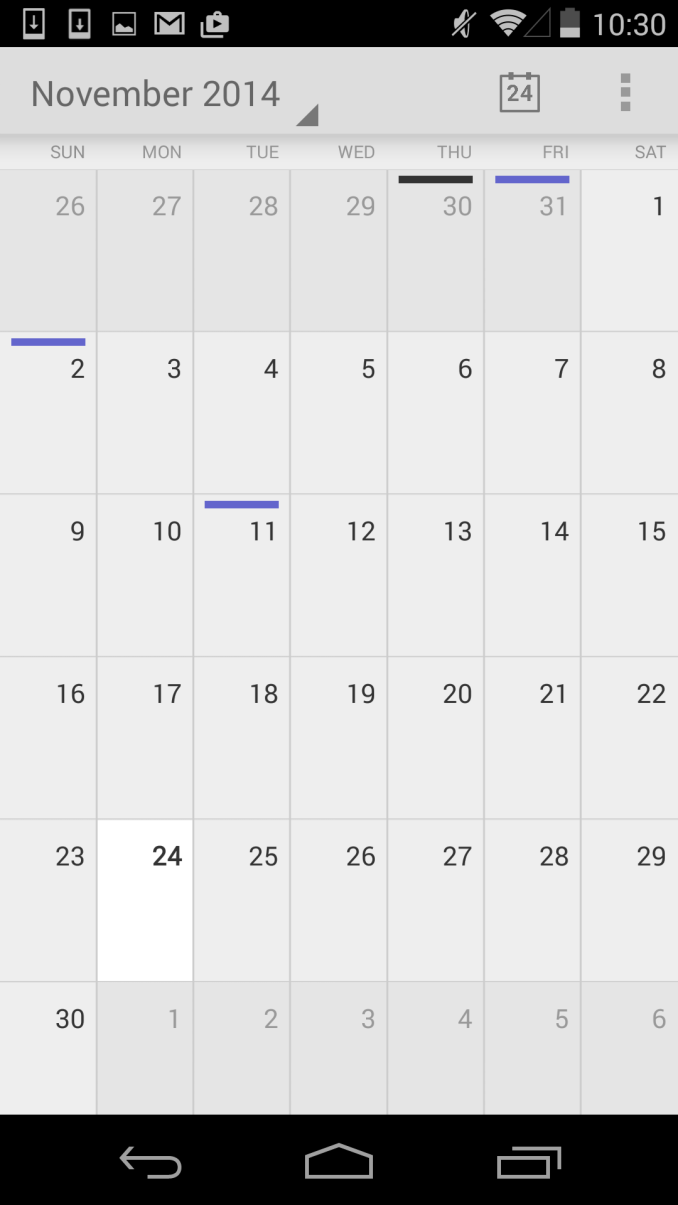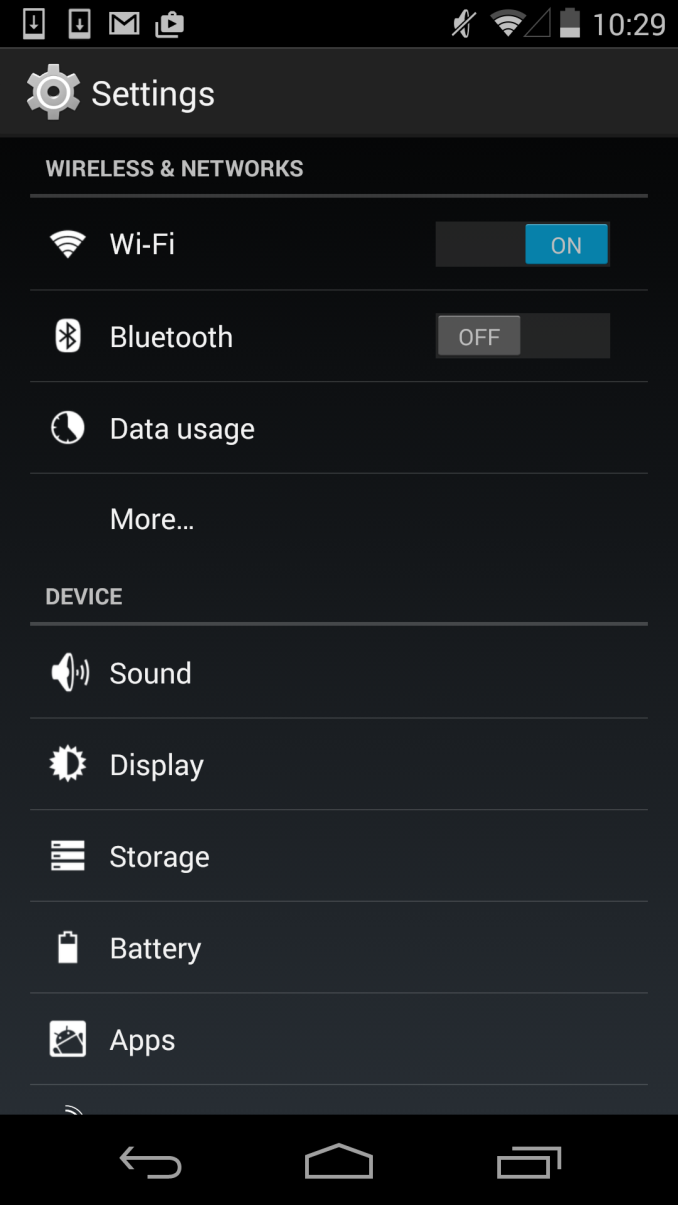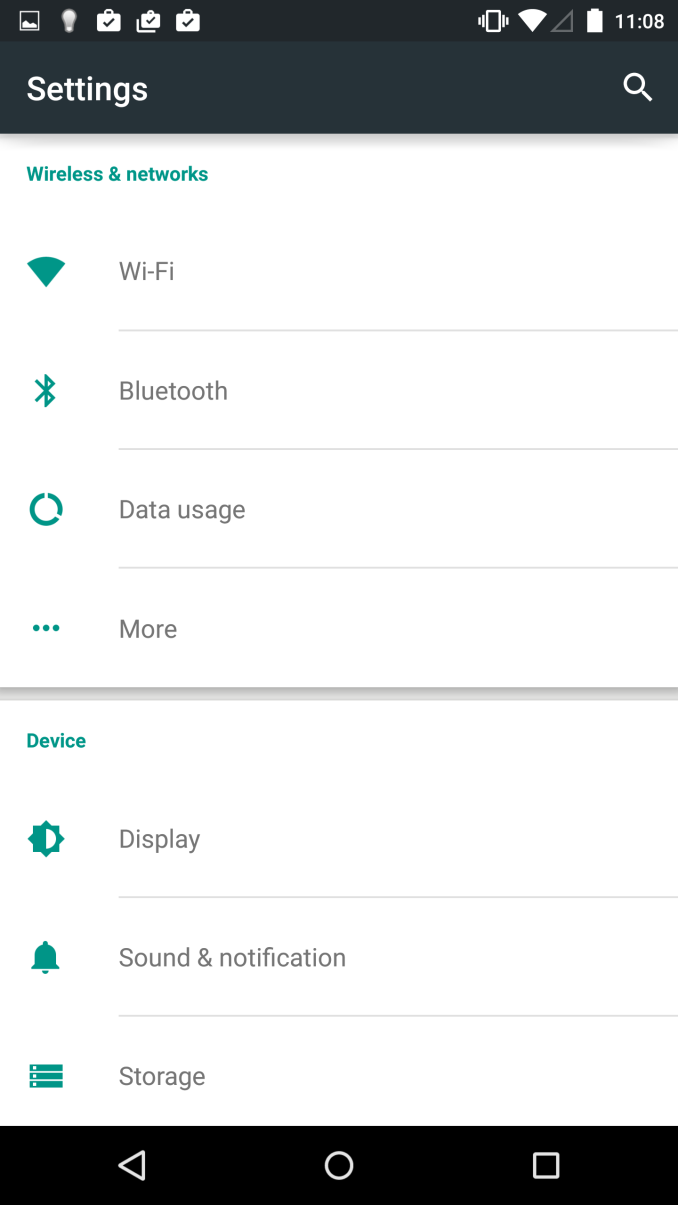The Android 5.0 Lollipop Review
by Brandon Chester on December 1, 2014 10:00 AM EST- Posted in
- Smartphones
- Android
- Tablets
- Android 5.0
Material Design
A good place to begin before discussing the operating system itself is to explain what exactly "Material Design" is. The term comes up a lot throughout the course of the review, which makes sense given how the biggest changes that users will see when moving from KitKat to Lollipop will be because of Material Design. Material Design is a set of design principles, and contained within them is something of a mission statement about Google's approach to services across multiple platforms. Material Design is definitely not Google's first big change to the Android interface, but this time I'm actually very confident that it will be the last we see for a very long time. I'm very impressed by the work Google has done to create an interface that looks and feels modern, simple, and beautiful. Before getting into what Material Design looks and acts like, I'd like to address and give my thoughts about Google's previous style of interface design which was called Holo.
To me, Holo always seemed like a transitional type of interface. Google had just brought on Matías Duarte, but as someone whose first smartphone was a Palm Pre, I didn't feel his influence anywhere at all. I think that Holo was a definite improvement over the previous Android interface, but that isn't really saying much. In my opinion, it still didn't feel coherent or look visually appealing. For example, if you showed me the two screens above without the status bar and navigation buttons, I would be hard pressed to tell you that they're from the same operating system. They don't share a single common interface element. The lack of color and use of grey was also questionable. While some users protest the heavy use of white in many modern interfaces, to me the grey that was commonly used in Holo Light applications was analogous to a dirty white cloth. The lacking color also made applications feel rather dull and lifeless, and I almost wondered if it was an effort to try and mask the fact that phones were shipping with either under-saturated or over-saturated displays by just having almost no color at all.
With my disappointment in Google's new interface, I was worried that it would just be something I would have to deal with for many years. Fortunately, less than one year after Android Ice Cream Sandwich was released, we were given a glimpse of the beginnings of a new type of design that was distinctly not Holo. It was in a feature called Google Now which launched with Android 4.1, and that many people now use everyday. This application used bright white cards to display relevant information, and had a much heavier use of color than any other applications that shipped along with Android. While at the time this could have been dismissed as the most obvious way to make an application that is constantly displaying and updating information for the user, in hindsight it was clearly the beginning of a new type of design being practiced at Google. It was still immature, lacking the animations, drop shadows, and dynamic nature of Material Design, but it began the dissolution of the Holo interface that had just been introduced.
Finally with the end of Holo, comes the beginning of Material. When Google gave a sneak peek of the new interface for Lollipop at Google IO I was very excited by what I saw seeing. The basic idea of the cards in Google Now had been applied to the entire operating system, and expanded upon in ways that I hadn't expected but have been pleasantly surprised by. As you can see above, both applications display the sections of the interface on white cards that float above the background and cast slight shadows. There's also a much greater use of color, and a better use of screen real estate by dividing the application into multiple sections which can be seen in the new Calendar application. The Settings application is actually a bad example in this regard, as the increased spacing means the main page fits less on screen than before, but this is an exception and I included it primarily to show the contrast between new and old.
Material Design is based upon the ideas of paper, lighting, shadows, depth, and color. While this sounds a lot like the skeuomorphic interface of previous versions of iOS, Material Design doesn't limit itself based on the actual limits of physical items like paper, and it doesn't go to the point where applications are merely digital recreations of real world objects. There's also a heavy use of animations. Everything you touch seems to respond with an elegant animation, and the different cards in the interface can expand, contract, and stack atop one another to create an extremely dynamic feel. It is truly hard to explain, and it's really something that needs to be used to be fully understood.
The last thing to say about Material Design is how it represents more than just a way to design applications. Like I said earlier, within Material Design is a mission statement about Google's approach to services across multiple platforms. Although I've discussed it within the context of the Android platform, Material Design is going to be what you see in Google's applications across every platform. From web apps, to Android, to Chrome, to iOS applications, you will see a consistent style of design that adapts to different display sizes, use models, and methods of input. Overall this is a great step forward in making Google's services consistent across all devices, but I think in the context of iOS applications Google may be going a bit too far by ignoring the design guidelines of that platform in favor of their own.














126 Comments
View All Comments
lpyihui - Tuesday, December 2, 2014 - link
How about Project Volta and the battery life on Nexus 5?Brandon Chester - Tuesday, December 2, 2014 - link
I responded earlier in the comments about this. There's really no way to benchmark Volta, it has no impact on anything like web browsing or video playback tests.genghisquan - Tuesday, December 2, 2014 - link
My experience with Lollipop went from positive to negative after the first week. I absolutely loved the concept & execution of Material Design. The other things that I was excited for with 5.0 was how smooth everything would feel and better battery performance. I'm so disappointed with those two things because things feel even more sluggish than it did on KitKat, and battery life isn't noticeably better at all! I seriously have sent more complaints/feedback while using Lollipop than I ever did on KitKat.Impulses - Tuesday, December 2, 2014 - link
Thank the Google Gods there's a setting in Chrome to disable it's tabs from invading the multi tasker, or I probably would've had to switch browsers.jabber - Tuesday, December 2, 2014 - link
I was really looking forward to just ONE thing from Lollipop for my Nexus 4 and that was the potential to use RAW capability for the camera.Unfortunately, Google decided not to update the Nexus 4 camera API. Thanks Google.
zodiacfml - Tuesday, December 2, 2014 - link
1. I don't feel the new Android much since I'm using a different launcher just to remove Google's search bar on the main screen.2. I like the flashlight capability, goodbye flashlight app. It still has a bug though. When it sleeps, it just stops working and the camera app will crash.
3. I appreciate the Auto rotate shortcut missing from the the previous.
4. Battery life seems the same. I have been using the excellent Greenify App. Yet, there should be a way to control power draining issue when the phone has little or no cellular signal.
5. ART has probably remove very small stutters in some apps. Overall, my N5 is very smooth and quick and nothing left to ask for.
6. Google camera HDR has become slower and faster depending on the scene. It's still the best way to get good photos from a smartphone. I hope for manual controls, RAW mode, and other powerful features such as 60 fps video capture on 720p.
7. Now the UI and most messaging/social apps use white background, there should definitely a content aware Auto Brightness control so that it lowers the backlight for such content and then boosts again for full screen photos or videos.
8. A very small and niche annoyance for is the missing IP Address from the WiFi information page. In 5.0, I can only find it in About Phone - Status. I currently use my phone to troubleshoot WiFi connectivity at work and implementation of 5GHz AP setup.
9. I don't like the Photo app. It still feels the Backup Photo App. I have to download a 3rd party app for viewing pictures since they have removed the Gallery app.
10. There should be an option to bring out the keyboard immediately when unlocking the phone. In 5.0, it will require to swipe the lock icon first which is probably useful if you to want to read your notifications first before deciding to unlock the phone.
darkich - Tuesday, December 2, 2014 - link
What a disappointing review.Pointless talk about frame rates and not a word about aspects that actually have practical merit and value - comparative battery endurance and application loading times.
Sigh
Alexey291 - Thursday, December 4, 2014 - link
I know its like I'm on engadget or something...IKeelU - Tuesday, December 2, 2014 - link
As an N4 user who's been using the Google Now launcher since it was available as a standalone APK last year (for those who haven't tried it, you can get it from the google play store now and it's terrific), I didn't feel as "shocked" by lollipop as I did by kitkat. Like with all android updates, it feels like the google apps were gradually updated prior to the OS update so I was already sort of used to the design changes.If your apps were fully updated, and you've been using Google Now Launcher, in day-to-day use there's really just 3 main changes: notification bar, homescreen, general smoothness. All good changes IMO.
oturn - Tuesday, December 2, 2014 - link
"I think what can be said is that overall, Android is pretty much at the same level as Windows Phone and iOS for animation smoothness and general performance."Crazy talk! I have a 2nd gen Moto X with Lollipop, and an iPhone 6. I switch between them weekly. The smoothness and general performance of the iPhone 6 / iOS is ALWAYS a breath of fresh air compared to Android, Lollipop included. I hate it, because I prefer Android, but there it is. It slaps me in the face every time. There's nothing subjective it. It's obvious.